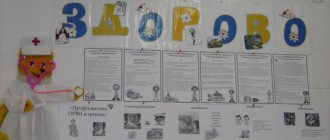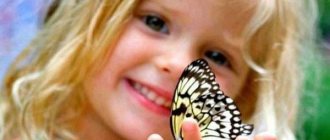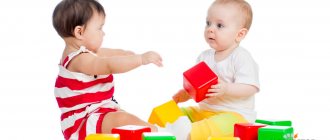“Preserving and strengthening the health of children in preschool educational institutions”
Preserving and strengthening the health of children in preschool educational institutions
Raising a healthy child is one of the most important tasks of a family and preschool institution.
Health is not only the absence of disease or physical defects, but also complete physical, mental and social well-being. It is the most important indicator that reflects the biological characteristics of the child, the conditions of upbringing, education of children, their life in the family, the quality of the environment, the degree of development of medical care, maternal and child health services, and ultimately the state’s attitude to health problems.
In a preschool educational institution, the primary task is to protect and strengthen the health of children. The work of teachers is aimed at maintaining a cheerful, cheerful mood in the child, preventing negative emotions and nervous breakdowns; improvement of all body functions, full physical development, nurturing interest in various available types of motor activity, forming the foundations of physical culture, the need for daily physical exercise, nurturing positive moral and volitional qualities.
Physical education in a preschool educational institution is carried out both in
special physical education classes, and in play activities and in the daily life of children, in various forms of organizing motor activity .
Favorable sanitary and hygienic conditions are created in the kindergarten, a daily routine is observed, and caring care is provided for each child based on a person-oriented approach; nutritious meals and daily exposure to fresh air are provided; Tempering activities and morning exercises are systematically carried out at all times of the year, and if appropriate conditions are available, swimming lessons are organized for children. In all age groups, much attention is paid to developing correct posture in children.
The expansion of the child’s individual motor experience, consistent learning of movements and motor actions: correct, rhythmic, easy walking, running, the ability to jump from a place and with a running start, various types of throwing, climbing, movements with balls, do not go unnoticed. Children are taught to clearly, rhythmically, and at a certain pace perform various physical exercises by demonstration and based on verbal descriptions; the learned movements are performed to music.
Educators create an environment in a preschool institution that is conducive to the development of personal hygiene skills. Children are taught to understand the value of a healthy lifestyle, to take care of their health, and are introduced to the basic rules of safe behavior.
Various types of hardening procedures are systematically carried out under the guidance of a medical professional, taking into account the individual characteristics of children.
Morning exercises are held daily
in a ventilated area.
During organized educational activities that require a lot of mental stress, and in the intervals between them, physical education sessions lasting 1-3 minutes are held.
In a preschool institution, the leading activity is play
. In order to prevent overwork in preschool educational institutions, traditional classes are replaced by complex ones, which are conducted in a playful way.
Teachers provide sufficient age-appropriate motor activity for children throughout the day, using outdoor activities, sports, folk games and physical exercises.
Every month there are physical training exercises and holidays
.
At the present stage, the task of our society is to educate healthy, harmoniously developed people with high mental and physical performance. To successfully solve this problem, it is important, as they say, to “take care of your health from a young age.” This means that it is necessary to strengthen the child’s health from the first days of his life.
An effective means of promoting health, reducing morbidity and increasing the level of performance of children is hardening the body. Sun, air and water are factors whose systematic exposure increases the body’s resistance to changing weather conditions.
Hardening
– this is not only wiping or dousing, but also everyday ordinary procedures that do not require special organization or additional time: staying indoors and outdoors in appropriate clothing, washing with cool water, sleeping with an open vent or window, active physical exercise.
Air acts as a complex irritant, enhancing metabolic processes, increasing the amount of hemoglobin and red blood cells, strengthening the nervous system. Its beneficial effect is also manifested in the child’s mood - he becomes cheerful and cheerful. It is necessary to use fresh air for hardening purposes constantly, at any time of the year. Cold winter air in combination with active physical exercise and games has a particularly beneficial effect. For the proper development of a child, it is important that he is exposed to the air for 4-5 hours in winter, and almost all day in summer. When organizing outdoor walks for children, adults should create conditions for their active activities.
A good way to improve health is water hardening.
Children love to play with her; Such activities improve the mood and evoke joyful emotions in the child. This should be used to improve the health of the body. It is better to start water procedures in the warm season. Wash the children with cool water. First, wash your hands up to your elbows, then your neck and face.
One of the effective methods of hardening is contrasting dousing of the feet: first with cold water - 24-25 degrees, then warm - 36 degrees and again cold.
The most powerful healing and hardening remedy is swimming in a pond. For a healthy child, it is permissible from the age of 2 years at an air temperature of 25 - 28 degrees and a water temperature of at least 22 degrees.
It must be remembered that the hardening effect of the applied influences depends on the systematicity, continuity of use, gradually increasing intensity of the procedures, and taking into account the individual sensitivity of the child.
If measures to improve a child’s health, carried out in kindergarten, are complemented by daily exercises and outdoor games in a family environment, he develops individual inclinations and interests. Children are especially susceptible to the beliefs, positive behavior of their father, mother, and family lifestyle. Therefore, the educator needs to improve the methods of pedagogical propaganda among parents, to involve them in the active pedagogical process, so that the knowledge they acquire is embodied in the specific work of raising children.
Of great importance in the process of developing good posture are a strictly observed daily routine, the size of furniture, and the posture of children during organized educational activities, labor and other types of independent activities.
Morning exercises are one of the most important components of children’s motor regimen. It is aimed at improving the health, strengthening, increasing the functional level of body systems, developing the physical qualities and abilities of children, and consolidating motor skills. The need to start doing morning exercises after waking up develops the child’s volitional qualities: will, perseverance, discipline, perseverance, independence.
Morning exercises are also valuable because children develop the habit of performing various exercises every day in the morning. Over time, this useful habit turns into a need and remains with the person for life.
After intense physical activity, breathing exercises are necessary to restore breathing. In preschool children, the respiratory muscles are weak, so breathing exercises are very useful. They promote full physical development and prevent diseases of the respiratory system.
Early childhood is a period of intense physical and mental development. It is at this age that the mental and moral development of a child especially depends on his physical condition and mood.
Preschool education plays a significant role in creating conditions for the harmonious development of a person, which is impossible without physical education.
To this end, to make physical education classes interesting and exciting for children, teachers develop a variety of entertaining elements aimed at activating children’s motor activity, developing dexterity and coordination.
The great value of every person is health.
Raising a child strong, strong, and healthy is the desire of parents and one of the leading tasks facing a preschool institution.
The joint activities of teachers - children - parents allows:
- increase the efficiency of work on children's health;
- obtain the necessary knowledge about the physical development of the child;
- create a need for a healthy lifestyle in your family;
- reduce the “deficit” of positive emotions in children, create a festive atmosphere during joint sports activities;
- see and learn about the work of a kindergarten on the physical development of children;
- to ensure continuity of methods and techniques of raising children in the family and in kindergarten.
Many years of experience in such work show that the results of physical education and sports are high when there is interaction between the family and the kindergarten.
Working together helps to strengthen and preserve the child’s health, develop his strength and endurance, physical abilities, and increase his body’s resistance to disease.
It is necessary to teach children from an early age:
- safety at home;
- the ability and desire to be neat and tidy;
- introduce the rules of communication with animals;
- develop road behavior skills;
- cultivate caution in communication;
- establish rules of behavior on the water and in public;
- develop aesthetic taste.
Only the professional competence of teachers of a preschool educational institution, love for their profession and, of course, for children, contribute to the preservation and strengthening of children’s health. Children are the future of our society. And, therefore, their well-being depends on us.
ABOUT HARMFUL WHITE PRODUCTS
“I have reverence for the doctor, I have been fulfilling many of his requirements since the birth of my daughter, but she still gets sick often.
“It was the same for us until we changed our diet.” At first, the children were fed according to the menu provided by Komarovsky. There was nothing harmful in it - no sausages, no semi-finished products, and from the age of 2 to 3, strictly dairy-free porridge. But overall - ordinary food. During this same period, my son became ill, was diagnosed with asthma and was prescribed hormones for several months. My husband and I began to delve into it and found an immunologist-nutritionist.
The doctor, without a single analysis, issued a prescription: eliminate everything white from the diet - cottage cheese, milk, sugar, flour. And train your breathing: swimming, skiing, running... He will ask for treats - give him an apple, a cucumber, a carrot. But no buns, cottage cheese or sweets.
We changed the menu, gave up medications, and after six months the spasms completely disappeared.
We looked at the statistics on contract terminations in kindergartens: most of them were in winter and spring. (Due to the constant illnesses of children during this period, parents, as a rule, began to think: is it necessary to pay for a private kindergarten if they have to sit with the child on sick leave most of the time. - Ed.). And they decided to introduce the same nutrition in the kindergarten.
— But the nutritionist gave recommendations specifically for your son; it might not have been suitable for other children?
- I think this suits everyone. For both children and adults. Our menu was developed by specialists, and it is different than in any other educational institution.
ABOUT THE DON'T WANT
— Do children like proper food?
“If they eat differently at home, this is immediately visible in the child, especially in the first month or two. But to be consistent, taste habits change quite quickly. Although children are children. Salads made from fresh vegetables are not very popular. Oatmeal does not work well in water, so add banana, berries, and more butter.
- What if he doesn’t want to eat?
- We don’t force you. But there is one secret: there is such a movement here - walks, activities, excursions, games, classes - that everyone has a good appetite. And after lunch they sleep. There are especially active ones that you can’t roll down with anything, but there are only a few of them.
Principles of nutrition.
Photo: Dmitry POLUKHIN




